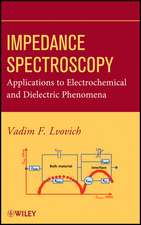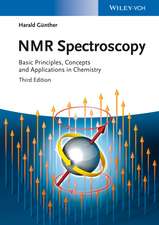Multiscale Characterization of Biological Systems: Spectroscopy and Modeling
Autor Vikas Tomar, Tao Qu, Devendra K. Dubey, Devendra Verma, Yang Zhangen Limba Engleză Paperback – 23 aug 2016
This book also:
•Details spectroscope experiments as well as nanomechanic experiments
•Reviews exhaustively phenomenological models and Raman spectroscopy of biological systems
•Covers the latest in multiscaling for molecular models to predict lab-scale sample properties and investigates interface thermomechanics
| Toate formatele și edițiile | Preț | Express |
|---|---|---|
| Paperback (1) | 631.07 lei 6-8 săpt. | |
| Springer – 23 aug 2016 | 631.07 lei 6-8 săpt. | |
| Hardback (1) | 637.13 lei 6-8 săpt. | |
| Springer – 2 dec 2015 | 637.13 lei 6-8 săpt. |
Preț: 631.07 lei
Preț vechi: 742.43 lei
-15% Nou
Puncte Express: 947
Preț estimativ în valută:
120.76€ • 126.66$ • 100.53£
120.76€ • 126.66$ • 100.53£
Carte tipărită la comandă
Livrare economică 01-15 aprilie
Preluare comenzi: 021 569.72.76
Specificații
ISBN-13: 9781493956074
ISBN-10: 1493956078
Pagini: 93
Ilustrații: X, 93 p.
Dimensiuni: 155 x 235 mm
Greutate: 0.16 kg
Ediția:Softcover reprint of the original 1st ed. 2015
Editura: Springer
Colecția Springer
Locul publicării:New York, NY, United States
ISBN-10: 1493956078
Pagini: 93
Ilustrații: X, 93 p.
Dimensiuni: 155 x 235 mm
Greutate: 0.16 kg
Ediția:Softcover reprint of the original 1st ed. 2015
Editura: Springer
Colecția Springer
Locul publicării:New York, NY, United States
Cuprins
Introduction.- Spectroscopic Experiments: A Review of Raman Spectroscopy of Biological Systems.- Nanomechanics Experiments: A Microscopic Study of Mechanical Property Scale Dependence and Microstructure of Crustaceans’ Thin Films as Biomimetic Materials.- Molecular Modeling: A Review of Nanomechanics Based on Molecular Modeling.- Multiscaling for Molecular Models to Predict Lab Scale Sample Properties: A Review of Phenomenological Models.- Multiscaling for Molecular Models: Investigating Interface Thermomechanics.- Index.
Notă biografică
Vikas Tomar is an Associate Professor at Purdue University-West Lafayette. His research focuses on understanding how interfaces contribute to failure of complex materials with a specific emphasis on microstructural issues. He has developed three different multiscale modeling methods and a new experimental scheme called nanomechanical Raman spectroscopy. Dr. Tomar has been a recipient of multiple research awards, including the inaugural Material Science and Engineering-C Young Researcher award. He is Editor-in-Chief of the International Journal of Experimental and Computation Biomechanics and is an Associate Editor of the Journal of Engineering Materials and Technology. He is an associate fellow of AIAA.
Devendra Dubey is an Assistant Professor in Mechanical Engineering Department at the Indian Institute of Technology Delhi, India. He received his Ph.D. from Purdue University, Indiana, USA; MS in mechanical engineering from University of Notre Dame, Indiana, USA; and Bachelor’s degree from Indian Institute of Technology Bombay, Mumbai, India. Dr. Dubey works in the general area of computational mechanics at multiple length scales with a focus on understanding interfacial interactions and structure-property. He has previously worked on nano
mechanics of polymer-ceramic type collagen-hydroxyapatite biomaterials and his current research involves nanomechanics of brittle of bone disease, impact mitigation of ballistic structures, biomechanics and bio-tribology of knee and hip joints, mechanical reliability of solar cells, and blast injury mechanics of human body.Yang Zhang is currently a doctoral student in the School of Aeronautics and Astronautics at Purdue University working with Dr. Vikas Tomar. His Ph.D. work is focused on characterization of high temperature crack tip plasticity and size effect in nickel based super alloy using nanomechanical Raman spectroscopy and high temperatureindentation. Yang graduated from the University of Science and Technology of China in June 2009 with a Bachelor’s degree in mechanical engineering. He received his Master’s degree in mechanical engineering from the University of Science and Technology of China in June 2012. He has received a Pan-Deng Scholarship in Mechanics from the Chinese Academy of Sciences and a NSF Fellowship for the Summer Institute Workshop on Extreme Resolution Bioimaging Technologies during his graduate study.
Devendra Verma is currently a doctoral student in the School of Aeronautics and Astronautics at Purdue University working with Dr. Vikas Tomar. His Ph.D. work is focused on understanding the interfacial damage mechanics of metallic and biomimetic materials during impact loading. Verma graduated from the Indian Institute of Technology, Kanpur in May 2011 with a Bachelor’s in Aerospace Engineering. He received his Master’s from Purdue
's School of AAE in December 2012. He has received several awards, including the ASME AMD Haythornthwaite Travel Award, the College of Engineering Outstanding Service Award, the WCCM-World Congress on Computational Mechanics Conference Travel Award, and the Graduate Student Excellence Award during his graduate study.Tao Qu is a doctoral student in Aeronautics and Astronautics Engineering at Purdue University–West Lafayette. His research focuses on understanding how interfaces contribute to failure of composite/biomimetic materials from atomistic- to continuum-level. He has developed the nanomechanics-based computational framework for modeling interface deformation as well as interface strength with atomistic computational method and finite element method. Tao Qu’s work has been published in Materials Science and Engineering: C, MRS Bulletin, and Acta biomaterialia, etc. He
received the National Science Foundation Fellowship for a workshop on bioimaging technologies in 2013.Textul de pe ultima copertă
This book covers the latest research work done in the area of interface mechanics of collagen and chitin-based biomaterials along with various techniques that can be used to understand mechanics of biological systems and materials. Topics covered include Raman spectroscopy of biological systems, scale dependence of the mechanical properties and microstructure of crustaceans thin films as biomimetic materials, as well as the role of molecular-level modeling. The use of nanomechanics to investigate interface thermomechanics of collagen and chitin-based biomaterials is also covered in detail.
This book also:
•Details spectroscope experiments as well as nanomechanic experiments
•Reviews exhaustively phenomenological models and Raman spectroscopy of biological systems
•Covers the latest in multiscaling for molecular models to predict lab-scale sample properties and investigates interface thermomechanics
This book also:
•Details spectroscope experiments as well as nanomechanic experiments
•Reviews exhaustively phenomenological models and Raman spectroscopy of biological systems
•Covers the latest in multiscaling for molecular models to predict lab-scale sample properties and investigates interface thermomechanics
Caracteristici
Details spectroscope experiments as well as nanomechanic experiments Reviews exhaustively phenomenological models and Raman spectroscopy of biological systems Covers the latest in multiscaling for molecular models to predict lab-scale sample properties and investigates interface thermomechanics













